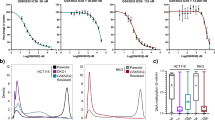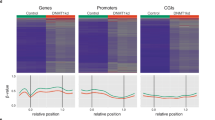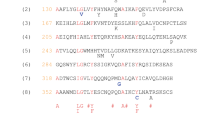Abstract
We examined the function of two key DNA methyltransferase (DNMT) enzymes in epigenetic regulation of X-linked cancer/germline (CG-X) antigen genes in human cancer cells, using MAGE-A1, NY-ESO-1, and XAGE-1 as models. In HCT116 cells, genetic knockout of DNMT1 caused moderate activation of CG-X genes, DNMT3b knockout had a negligible effect, and double knockout of both enzymes caused robust gene induction. Similarly, dual DNMT knockout caused dramatic hypomethylation of the MAGE-A1 and NY-ESO-1 promoters, DNMT1 knockout showed moderate hypomethylation, and DNMT3b knockout elicited only slight methylation changes. In contrast, both single and double knockout cells showed significant hypomethylation of the XAGE-1 promoter. RNA interference (RNAi) targeting of DNMT1 in HCT116 cells validated the results seen using genetic knockout cells; however, RNAi targeting of DNMT1 in a different colorectal cancer cell line revealed a greater independent role for DNMT1 in mediating CG-X gene repression and promoter methylation in other cell types. Notably, the histone H3 modification pattern at CG-X promoters was altered following DNMT knockout. DNMT1 or DNMT3b knockout reduced dimethylated lysine-9 (diMe-H3K9) levels, but did not significantly affect dimethylated lysine-4 (diMe-H3K4) or acetylated lysine-9 (Ac-H3-K9) levels. In contrast, dual DNMT1/3b knockout reduced the level of diMe-H3K9 and dramatically increased the levels of diMe-H3K4 and Ac-H3K9 at CG-X gene loci. In summary, DNMT1 and DNMT3b were found to perform both redundant and independent functions in epigenetic regulation of CG-X antigen genes in human cancer cells.
This is a preview of subscription content, access via your institution
Access options
Subscribe to this journal
Receive 50 print issues and online access
$259.00 per year
only $5.18 per issue
Buy this article
- Purchase on Springer Link
- Instant access to full article PDF
Prices may be subject to local taxes which are calculated during checkout







Similar content being viewed by others
References
Bachman KE, Park BH, Rhee I, Rajagopalan H, Herman JG, Baylin SB et al. (2003). Cancer Cell 3: 89–95.
Bestor TH . (2000). Hum Mol Genet 9: 2395–2402.
Bird AP, Wolffe AP . (1999). Cell 99: 451–454.
Cameron EE, Bachman KE, Myohanen S, Herman JG, Baylin SB . (1999). Nat Genet 21: 103–107.
Cheng JC, Yoo CB, Weisenberger DJ, Chuang J, Wozniak C, Liang G et al. (2004). Cancer Cell 6: 151–158.
Chomez P, De Backer O, Bertrand M, De Plaen E, Boon T, Lucas S . (2001). Cancer Res 61: 5544–5551.
Christman JK . (2002). Oncogene 21: 5483–5495.
Clark SJ, Harrison J, Paul CL, Frommer M . (1994). Nucleic Acids Res 22: 2990–2997.
De Smet C, De Backer O, Faraoni I, Lurquin C, Brasseur F, Boon T . (1996). Proc Natl Acad Sci USA 93: 7149–7153.
De Smet C, Loriot A, Boon T . (2004). Mol Cell Biol 24: 4781–4790.
De Smet C, Lurquin C, Lethe B, Martelange V, Boon T . (1999). Mol Cell Biol 19: 7327–7335.
Egger G, Liang G, Aparicio A, Jones PA . (2004). Nature 429: 457–463.
Frommer M, McDonald LE, Millar DS, Collis CM, Watt F, Grigg GW et al. (1992). Proc Natl Acad Sci USA 89: 1827–1831.
Fuks F, Hurd PJ, Deplus R, Kouzarides T . (2003). Nucleic Acids Res 31: 2305–2312.
Gardiner-Garden M, Frommer M . (1987). J Mol Biol 196: 261–282.
Gillespie AM, Coleman RE . (1999). Cancer Treat Rev 25: 219–227.
Guo ZS, Hong JA, Irvine KR, Chen GA, Spiess PJ, Liu Y et al. (2006). Cancer Res 66: 1105–1113.
Herman JG, Graff JR, Myohanen S, Nelkin BD, Baylin SB . (1996). Proc Natl Acad Sci USA 93: 9821–9826.
Jiang G, Yang F, Sanchez C, Ehrlich M . (2004). J Cell Biochem 93: 286–300.
Jones PA, Baylin SB . (2002). Nat Rev Genet 3: 415–428.
Karpf AR, Jones DA . (2002). Oncogene 21: 5496–5503.
Karpf AR, Lasek AW, Ririe TO, Hanks AN, Grossman D, Jones DA . (2004). Mol Pharmacol 65: 18–27.
Karpf AR, Moore BC, Ririe TO, Jones DA . (2001). Mol Pharmacol 59: 751–757.
Koslowski M, Bell C, Seitz G, Lehr HA, Roemer K, Muntefering H et al. (2004). Cancer Res 64: 5988–5993.
Lachner M, O'Sullivan RJ, Jenuwein T . (2003). J Cell Sci 116: 2117–2124.
Leu YW, Rahmatpanah F, Shi H, Wei SH, Liu JC, Yan PS et al. (2003). Cancer Res 63: 6110–6115.
Li LC, Dahiya R . (2002). Bioinformatics 18: 1427–1431.
Lyko F, Brown R . (2005). J Natl Cancer Inst 97: 1498–1506.
Maio M, Coral S, Fratta E, Altomonte M, Sigalotti L . (2003). Oncogene 22: 6484–6488.
Odunsi K, Jungbluth AA, Stockert E, Qian F, Gnjatic S, Tammela J et al. (2003). Cancer Res 63: 6076–6083.
Okano M, Bell DW, Haber DA, Li E . (1999). Cell 99: 247–257.
Qian F, Gnjatic S, Jager E, Santiago D, Jungbluth A, Grande C et al. (2004). Cancer Immun 4: 12.
Reynolds SR, Zeleniuch-Jacquotte A, Shapiro RL, Roses DF, Harris MN, Johnston D et al. (2003). Clin Cancer Res 9: 657–662.
Rhee I, Bachman KE, Park BH, Jair KW, Yen RW, Schuebel KE et al. (2002). Nature 416: 552–556.
Rhee I, Jair KW, Yen RW, Lengauer C, Herman JG, Kinzler KW et al. (2000). Nature 404: 1003–1007.
Robert MF, Morin S, Beaulieu N, Gauthier F, Chute IC, Barsalou A et al. (2003). Nat Genet 33: 61–65.
Robertson KD . (2001). Oncogene 20: 3139–3155.
Robertson KD, Uzvolgyi E, Liang G, Talmadge C, Sumegi J, Gonzales FA et al. (1999). Nucleic Acids Res 27: 2291–2298.
Rozen S, Skaletsky HJ . (2000). Bioinformatics Methods and Protocols: Methods in Molecular Biology In Krawetz S, Misener, S. (eds.). Humana Press: Totowa, NJ, pp 365–386.
Sigalotti L, Coral S, Nardi G, Spessotto A, Cortini E, Cattarossi I et al. (2002). J Immunother 25: 16–26.
Sigalotti L, Fratta E, Coral S, Tanzarella S, Danielli R, Colizzi F et al. (2004). Cancer Res 64: 9167–9171.
Simpson AJ, Caballero OL, Jungbluth A, Chen YT, Old LJ . (2005). Nat Rev Cancer 5: 615–625.
Song L, James SR, Kazim L, Karpf AR . (2005). Anal Chem 77: 504–510.
Suzuki M, Sunaga N, Shames DS, Toyooka S, Gazdar AF, Minna JD . (2004). Cancer Res 64: 3137–3143.
Tachibana M, Sugimoto K, Nozaki M, Ueda J, Ohta T, Ohki M et al. (2002). Genes Dev 16: 1779–1791.
Tachibana M, Ueda J, Fukuda M, Takeda N, Ohta T, Iwanari H et al. (2005). Genes Dev 19: 815–826.
Tao Q, Huang H, Geiman TM, Lim CY, Fu L, Qiu GH et al. (2002). Hum Mol Genet 11: 2091–2102.
Ting AH, Jair KW, Schuebel KE, Baylin SB . (2006). Cancer Res 66: 729–735.
Ting AH, Jair KW, Suzuki H, Yen RW, Baylin SB, Schuebel KE . (2004). Nat Genet 36: 582–584.
van der Bruggen P, Traversari C, Chomez P, Lurquin C, De Plaen E, Van den Eynde B et al. (1991). Science 254: 1643–1647.
Vire E, Brenner C, Deplus R, Blanchon L, Fraga M, Didelot C et al. (2006). Nature 439: 871–874.
Weber J, Salgaller M, Samid D, Johnson B, Herlyn M, Lassam N et al. (1994). Cancer Res 54: 1766–1771.
Weiser TS, Guo ZS, Ohnmacht GA, Parkhurst ML, Tong-On P, Marincola FM et al. (2001). J Immunother 24: 151–161.
Acknowledgements
We are grateful to Dr Bert Vogelstein of The Johns Hopkins University School of Medicine for providing the DNMT knockout HCT116 cell lines, and to Dr David Jones of the University of Utah for providing the siRNA oligonucleotides targeting DNMT1. We thank other members of the Karpf laboratory, Dr Jennifer Black of RPCI, and the reviewers of this manuscript for helpful suggestions. This work was supported by grants from The Ralph Wilson Medical Research Foundation, The Roswell Park Alliance Foundation, and Phi Beta Psi (to ARK), and by NCI cancer center grant CA16056 (to Roswell Park Cancer Institute).
Author information
Authors and Affiliations
Corresponding author
Additional information
Supplementary Information accompanies the paper on the Oncogene website (http://www.nature.com/onc).
Rights and permissions
About this article
Cite this article
James, S., Link, P. & Karpf, A. Epigenetic regulation of X-linked cancer/germline antigen genes by DNMT1 and DNMT3b. Oncogene 25, 6975–6985 (2006). https://doi.org/10.1038/sj.onc.1209678
Received:
Revised:
Accepted:
Published:
Issue Date:
DOI: https://doi.org/10.1038/sj.onc.1209678
Keywords
This article is cited by
-
The CAR macrophage cells, a novel generation of chimeric antigen-based approach against solid tumors
Biomarker Research (2023)
-
Transcriptional overlap links DNA hypomethylation with DNA hypermethylation at adjacent promoters in cancer
Scientific Reports (2021)
-
DNA hypomethylation drives changes in MAGE-A gene expression resulting in alteration of proliferative status of cells
Genes and Environment (2020)
-
DNMT1 as a therapeutic target in pancreatic cancer: mechanisms and clinical implications
Cellular Oncology (2020)
-
Expression of cancer–testis antigens in esophageal cancer and their progress in immunotherapy
Journal of Cancer Research and Clinical Oncology (2019)



